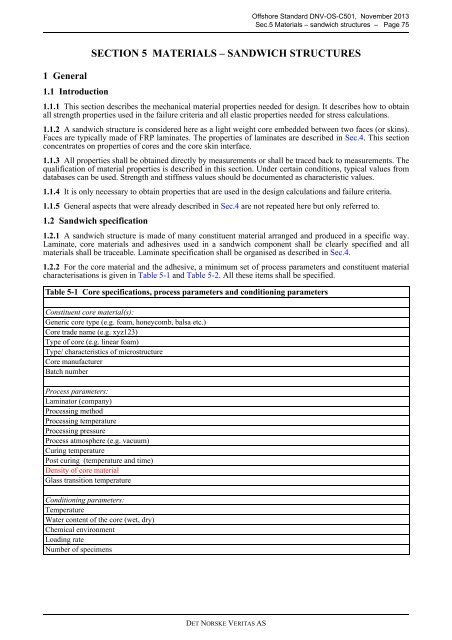OS-C501
You also want an ePaper? Increase the reach of your titles
YUMPU automatically turns print PDFs into web optimized ePapers that Google loves.
Offshore Standard DNV-<strong>OS</strong>-<strong>C501</strong>, November 2013<br />
Sec.5 Materials – sandwich structures – Page 75<br />
1 General<br />
1.1 Introduction<br />
SECTION 5 MATERIALS – SANDWICH STRUCTURES<br />
1.1.1 This section describes the mechanical material properties needed for design. It describes how to obtain<br />
all strength properties used in the failure criteria and all elastic properties needed for stress calculations.<br />
1.1.2 A sandwich structure is considered here as a light weight core embedded between two faces (or skins).<br />
Faces are typically made of FRP laminates. The properties of laminates are described in Sec.4. This section<br />
concentrates on properties of cores and the core skin interface.<br />
1.1.3 All properties shall be obtained directly by measurements or shall be traced back to measurements. The<br />
qualification of material properties is described in this section. Under certain conditions, typical values from<br />
databases can be used. Strength and stiffness values should be documented as characteristic values.<br />
1.1.4 It is only necessary to obtain properties that are used in the design calculations and failure criteria.<br />
1.1.5 General aspects that were already described in Sec.4 are not repeated here but only referred to.<br />
1.2 Sandwich specification<br />
1.2.1 A sandwich structure is made of many constituent material arranged and produced in a specific way.<br />
Laminate, core materials and adhesives used in a sandwich component shall be clearly specified and all<br />
materials shall be traceable. Laminate specification shall be organised as described in Sec.4.<br />
1.2.2 For the core material and the adhesive, a minimum set of process parameters and constituent material<br />
characterisations is given in Table 5-1 and Table 5-2. All these items shall be specified.<br />
Table 5-1 Core specifications, process parameters and conditioning parameters<br />
Constituent core material(s):<br />
Generic core type (e.g. foam, honeycomb, balsa etc.)<br />
Core trade name (e.g. xyz123)<br />
Type of core (e.g. linear foam)<br />
Type/ characteristics of microstructure<br />
Core manufacturer<br />
Batch number<br />
Process parameters:<br />
Laminator (company)<br />
Processing method<br />
Processing temperature<br />
Processing pressure<br />
Process atmosphere (e.g. vacuum)<br />
Curing temperature<br />
Post curing (temperature and time)<br />
Density of core material<br />
Glass transition temperature<br />
Conditioning parameters:<br />
Temperature<br />
Water content of the core (wet, dry)<br />
Chemical environment<br />
Loading rate<br />
Number of specimens<br />
DET NORSKE VERITAS AS



